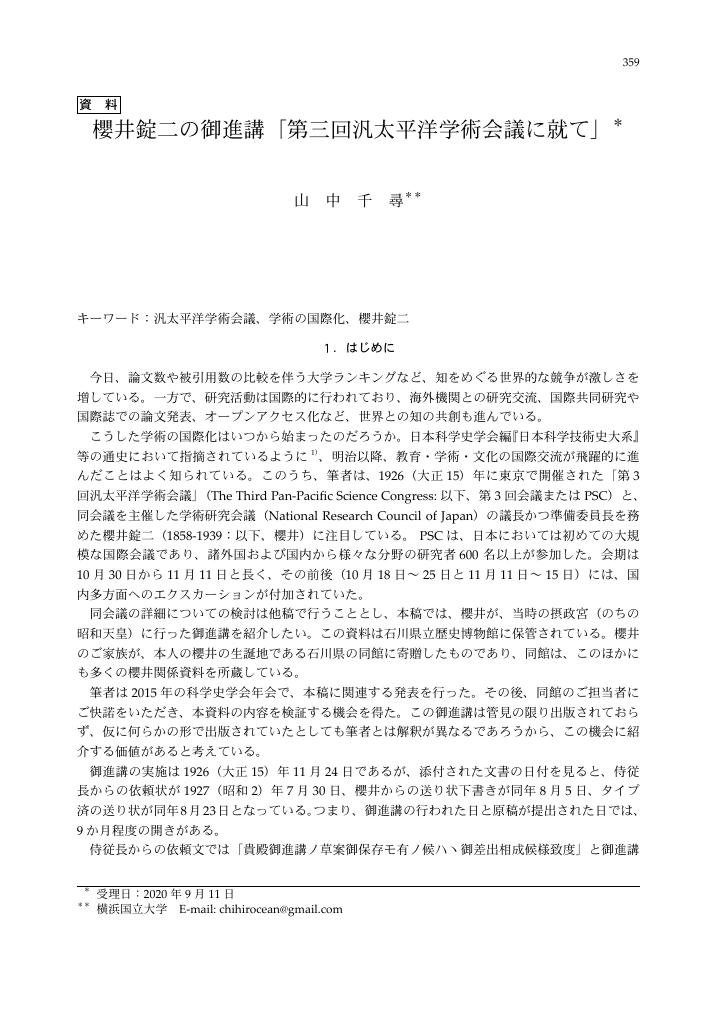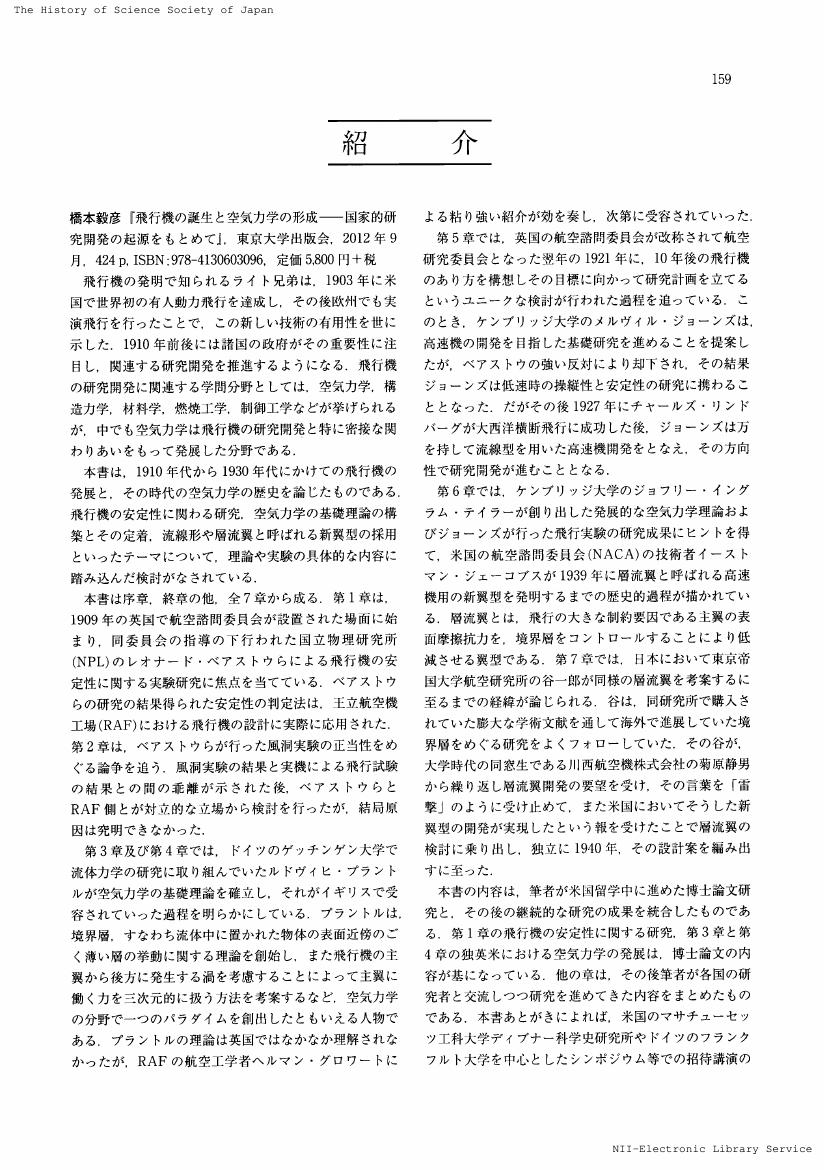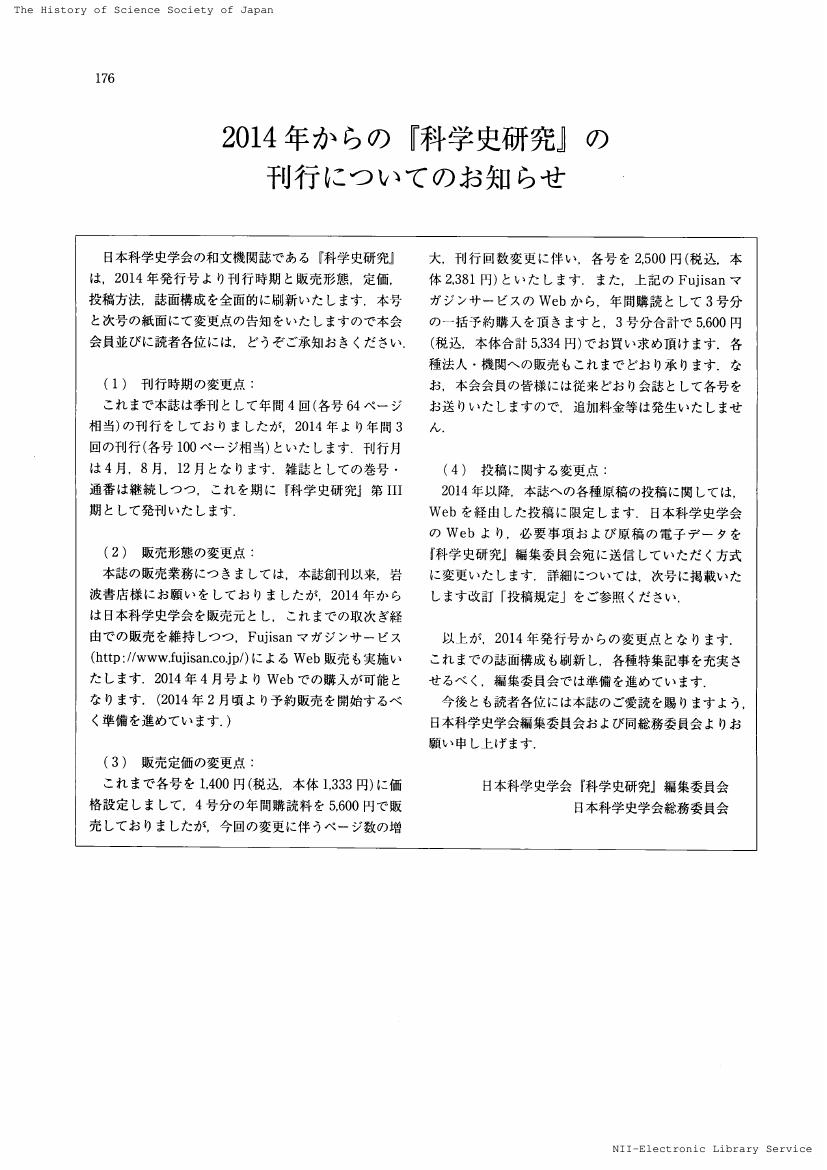1 0 0 0 OA 会長声明 政府による日本学術会議会員候補の任命拒否の撤回をもとめる
- 著者
- 木本 忠昭
- 出版者
- 日本科学史学会
- 雑誌
- 科学史研究 (ISSN:21887535)
- 巻号頁・発行日
- vol.59, no.296, pp.307-310, 2020 (Released:2021-10-06)
1 0 0 0 OA 資料 櫻井錠二の御進講「第三回汎太平洋学術会議に就て」
- 著者
- 山中 千尋
- 出版者
- 日本科学史学会
- 雑誌
- 科学史研究 (ISSN:21887535)
- 巻号頁・発行日
- vol.59, no.296, pp.359-376, 2020 (Released:2021-10-06)
1 0 0 0 OA 科学史入門 証明の発明と発展 ―ギリシャ数学の創始・発展とその遺産
- 著者
- 斎藤 憲
- 出版者
- 日本科学史学会
- 雑誌
- 科学史研究 (ISSN:21887535)
- 巻号頁・発行日
- vol.59, no.296, pp.387-393, 2020 (Released:2021-10-06)
1 0 0 0 OA アゴラ 散歩中に遭遇した近くの医療遺産と化学遺産
- 著者
- 溝畑 典宏
- 出版者
- 日本科学史学会
- 雑誌
- 科学史研究 (ISSN:21887535)
- 巻号頁・発行日
- vol.59, no.296, pp.394-396, 2020 (Released:2021-10-06)
- 著者
- 小林 昭三 興治 文子
- 出版者
- 日本科学史学会
- 雑誌
- 科学史研究 (ISSN:21887535)
- 巻号頁・発行日
- vol.52, no.268, pp.200-210, 2013 (Released:2021-07-12)
- 被引用文献数
- 1
We found varieties of students' notebooks on science in Middle Meiji Era(MME) in various regions of Japan. By investigating these historically valuable primary documents, i. e. "Buturi Hikki and Kagaku Hikki", we gained a deep insight into Japanese science education and clarified those real situations in MME. We also revealed what and how science was taught by using science text books and experimental tools shown in those notebooks in MME. Especially important results of those are verification of the real usage of the "Shogakko Seitoyo Butsurisho" "Physics for Elementary School" Students in English, by various note or memo written by pupils (or teachers) of primary school of Niigata, Saitama, Gunma, etc. in 1885-1897 of MME. Furthermore, we found how Japanese teachers developed their own styles of science teaching based on Japanese culture and how they cached up to the top level of the worlds by worldwide connections and by using hands-on tools in MME for learning actively.
- 著者
- 高橋 浩
- 出版者
- 日本科学史学会
- 雑誌
- 科学史研究 (ISSN:21887535)
- 巻号頁・発行日
- vol.52, no.268, pp.211-220, 2013 (Released:2021-07-12)
At the beginning of the Meiji era, Japan imitated the science teaching systems and curricula of Western countries. Individual subjects, such as physics and chemistry, were taught in elementary schools. After that, a new comprehensive science subject termed "Rika", was introduced in the middle Meiji era. So far, a relatively large number of papers on this change from the individual science subjects to "Rika" have been published. However, many of them have dealt mainly with the educational system or science textbooks; the actual state of science education in classrooms at that time has not been revealed. In this article, I have tried to clarify the actual science education that took place in the middle Meiji era Japan by investigating the two following historical records. The first record is examination problems that were actually used to test the students in Maebashi Higher Elementary School during 1888-1897. The second record is Jun'ichi Udagawa's reports on his lectures in Gunma Normal School. Jun'ichi Udagawa was one of the leaders in physics education in Meiji era Japan. The analysis of examination problems revealed that many of the problems were faithful to related laws and regulations and that Maebashi Higher Elementary School coped sequentially with the changes in the science curriculum by school year progress. A comparison between Udagawa's reports and textbooks edited or written by him during these times indicated that Udagawa actually used the teaching methods that were introduced in his textbooks, and that he wrote or edited some of his textbooks, based on his own experience of giving lectures in Gunma Normal School.
- 著者
- 所澤 潤
- 出版者
- 日本科学史学会
- 雑誌
- 科学史研究 (ISSN:21887535)
- 巻号頁・発行日
- vol.52, no.268, pp.221-230, 2013 (Released:2021-07-12)
- 被引用文献数
- 1
The recently discovered physics notebook kept by Ms. Sho Iyoku around 1890 suggests a new perspective on the method of using the textbook Physics for Elementary School Students by Makita Goto et al. published in 1885, which is well-known as one of the best textbooks ever to be published in the history of science education in Japan. However, it has not been examined at all how it had been used in the classroom despite the fact that it is one of the most important dimensions of the evaluation of this document. The author analyzes Iyoku's notebook by combining the new knowledge of the question-and-answer method with the structure of each unit in the textbook. He then suggests that it is probable the teacher taught physics to pupils by making them copy what he wrote on a blackboard after the actual experiments in order not to make pupils refer to the textbook prior to the experiment. The author concludes that Iyoku's notebook may represent one of the first examples preceding the new teaching methodology dubbed "substitute notebook", which became widespread around 1900.
- 著者
- 赤羽 明
- 出版者
- 日本科学史学会
- 雑誌
- 科学史研究 (ISSN:21887535)
- 巻号頁・発行日
- vol.52, no.268, pp.231-239, 2013 (Released:2021-07-12)
- 被引用文献数
- 1
Many students' science notebooks written in Middle Meiji Era(MME) have been found in various regions of Japan recently. From the study of such documents, we can understand the actual situation of education at that time. In this paper we discussed the results of the analysis of Physics Note written by a student Iyoku Shou, the first of such discovered documents. As a result, it is considered that this document refers to a textbook by Makita Goto et al., "Physics for Elementary School Students".
- 著者
- 興治 文子 小林 昭三
- 出版者
- 日本科学史学会
- 雑誌
- 科学史研究 (ISSN:21887535)
- 巻号頁・発行日
- vol.52, no.268, pp.240-248, 2013 (Released:2021-07-12)
- 被引用文献数
- 1
Modern science education was started in early Meiji era. It is said that the purpose of science education at the compulsory education level had changed qualitatively in middle Meiji Era. Public laws and published text- books were used to study this change, but it was not still clear what happened in the real science classrooms. We discovered students' science notebooks at middle Meiji Era in various regions on Japan. These notebooks are primary resources to reflect on science classes in middle Meiji Era. We analyzed these notebooks and found that teachers were using inventive approaches to promote students' understanding of science concepts.
1 0 0 0 OA 史料としての「編輯後記」
- 出版者
- 日本科学史学会
- 雑誌
- 科学史研究 (ISSN:21887535)
- 巻号頁・発行日
- vol.52, no.268, pp.249-254, 2013 (Released:2021-07-12)
1 0 0 0 OA 2014年からの『科学史研究』の刊行についてのお知らせ(第2報)
- 出版者
- 日本科学史学会
- 雑誌
- 科学史研究 (ISSN:21887535)
- 巻号頁・発行日
- vol.52, no.268, pp.256, 2013 (Released:2021-07-12)
- 著者
- 佐藤 賢一
- 出版者
- 日本科学史学会
- 雑誌
- 科学史研究 (ISSN:21887535)
- 巻号頁・発行日
- vol.52, no.267, pp.129-133, 2013 (Released:2021-07-12)
- 著者
- 松原 洋子
- 出版者
- 日本科学史学会
- 雑誌
- 科学史研究 (ISSN:21887535)
- 巻号頁・発行日
- vol.52, no.267, pp.134-143, 2013 (Released:2021-07-12)
- 著者
- 和文誌編集委員会
- 出版者
- 日本科学史学会
- 雑誌
- 科学史研究 (ISSN:21887535)
- 巻号頁・発行日
- vol.52, no.267, pp.144-148, 2013 (Released:2021-07-12)
1 0 0 0 OA 第7回日本科学史学会賞の報告
- 出版者
- 日本科学史学会
- 雑誌
- 科学史研究 (ISSN:21887535)
- 巻号頁・発行日
- vol.52, no.267, pp.149-152, 2013 (Released:2021-07-12)
1 0 0 0 OA 第60回日本科学史学会年会・総会報告
- 出版者
- 日本科学史学会
- 雑誌
- 科学史研究 (ISSN:21887535)
- 巻号頁・発行日
- vol.52, no.267, pp.153-158, 2013 (Released:2021-07-12)
1 0 0 0 OA 紹介
- 出版者
- 日本科学史学会
- 雑誌
- 科学史研究 (ISSN:21887535)
- 巻号頁・発行日
- vol.52, no.267, pp.159-162, 2013 (Released:2021-07-12)
1 0 0 0 OA 2014年からの『科学史研究』の刊行についてのお知らせ
- 出版者
- 日本科学史学会
- 雑誌
- 科学史研究 (ISSN:21887535)
- 巻号頁・発行日
- vol.52, no.267, pp.176, 2013 (Released:2021-07-12)
- 著者
- 由井 秀樹
- 出版者
- 日本科学史学会
- 雑誌
- 科学史研究 (ISSN:21887535)
- 巻号頁・発行日
- vol.52, no.268, pp.177-186, 2013 (Released:2021-07-12)
Little is known about the meaning of medical intervention in the area of male infertility in Japan. In order to investigate this issue, this paper analyzes the topic through a review of professional journals for obstetricians and gynecologists in Japan from the mid-1930s to the mid-1950s. The paper shows how artificial insemination by donor (AID) was introduced into the study of obstetrics and gynecology in Japan as a part of male infertility studies. The research clarifies four main points. First, the introduction of AID by Ando Kakuichi, who was an obstetrician and gynecologist at Keio University was related to contraception studies; due to the rapid population increase at the time, contraception studies were encouraged. Second, although there had been little investigation into male infertility problems until World War II, Ando regarded male infertility as an important issue and introduced AID after the war. Third, some obstetricians and gynecologists were opposed to AID; at Keio University, AID was seen as the last resort for male infertility, and in the mid-1950s, in order to obviate the need for AID as far as possible, new male fertility tests were developed, and ways to help sperm recover their viability were published. Fourth, after the introduction of AID by Ando, male infertility studies were also developed at other universities and they formed an important subject in the field. Consequently, not only the female body but also the male body became an object of intervention in obstetrics and gynecology in Japan.













